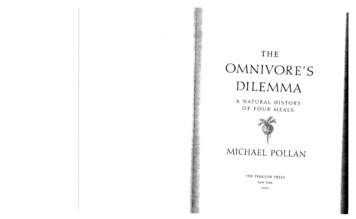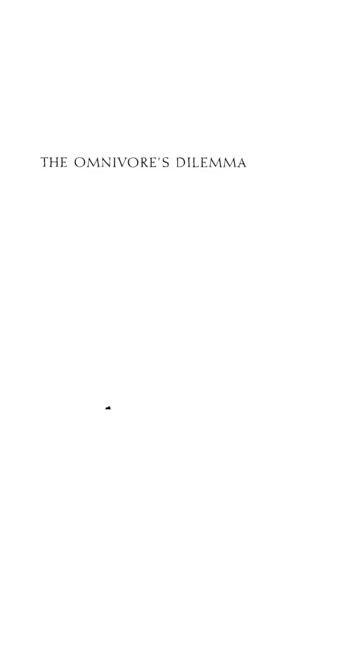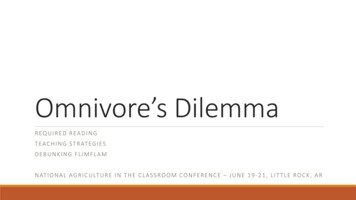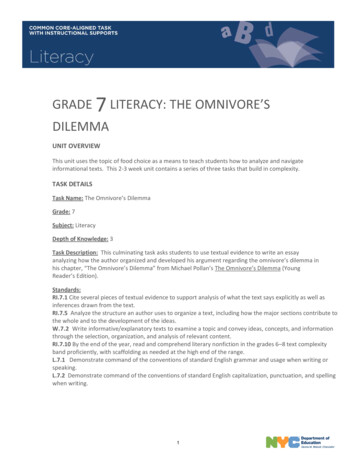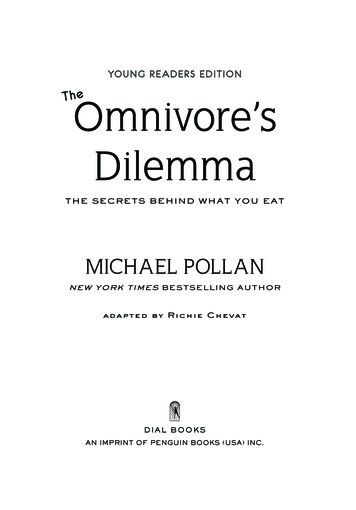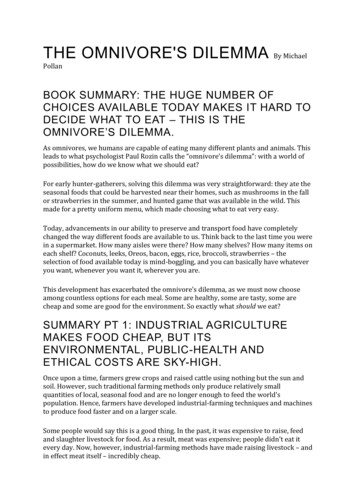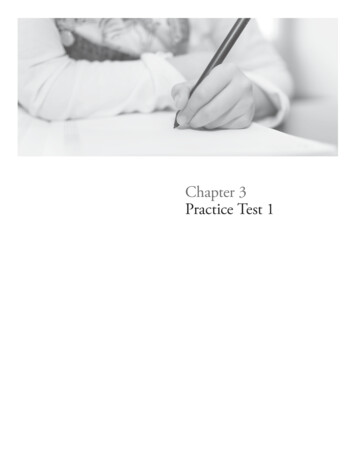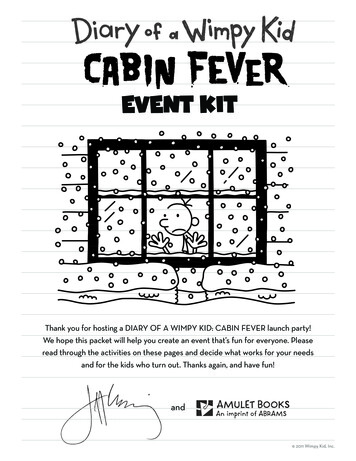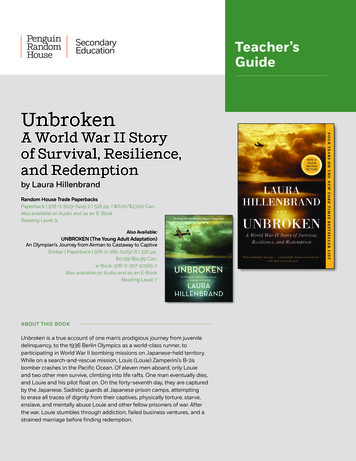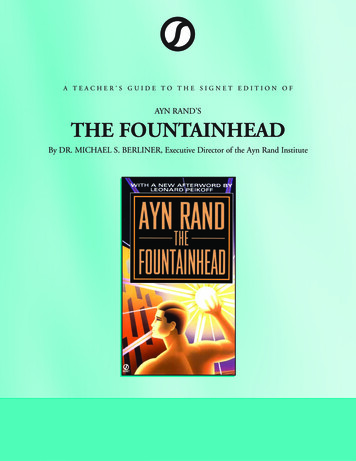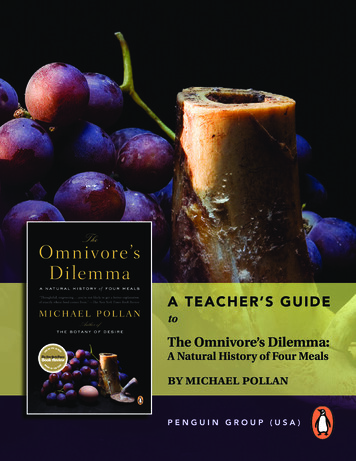
Transcription
A TEA CHER’ S GUIDEtoThe Omnivore’s Dilemma:A Natural History of Four Mealsby michael pollanPENGUIN GROUP (USA)
I. INTRODUCTIONPollan begins his book with a seemingly simplequestion — What should we have for dinner? —that he believes modern Americans have lost theability to answer. Confused and anxious aboutwhat we should be eating, we rely on outside,“expert” advice, from food scientists, nutritionists, and investigative journalists, to decide whatto put on the table each night. Pollan wants toknow how we lost our way.For him, America reached a new level of absurdity in 2002, when the Atkins diet saw a resurgenceand, almost overnight, carbohydrates became dietary villains (replacing fat as our nutritional enemy number one). Pollan hypothesizes that anyculture that could change its eating habits on adime must have some sort of eating disorder because such a thing “never would have happenedin a culture in possession of deeply rooted traditions surrounding food and eating.” (2) After all,why do Americans — unlike people in most other countries in the world — rely onthe government to come up with dietary goals to tell them what to eat?Why do we choose our meals onthe “food pyramid” — which itselfchanges every few years and is oftendependent more on politics thanon science? Why do we pay moreattention to the percentages of vitamins in our breakfast than we doto its taste, or substitute “nutritionbars” for meals? Pollan points outthat Americans seem mystified bythe “French paradox” — that is, thequestion of how a culture that consumes so much cheese, wine andcroissants can possibly be healthierthan we are. But he says that perhaps instead we should be examining the “American paradox”: “a notably unhealthy people obsessed bythe idea of living healthily.” (3)Pollan thinks that Americans are struggling withwhat he refers to as the “omnivore’s dilemma” —if you can eat anything (and, in the case of Americans, have an incredible abundance of availablefood), then what should you eat? Sure, naturegave us some basic guidelines: Toxic foods oftentaste bitter. Where there’s sugar, there are calories. And most cultures have traditions that surround food — like recipes, taboos and rituals— that help guide them toward what they’re sup-2posed to eat. But in America, Pollan says, we’velost this connection with the past. A nation ofimmigrants, we’ve never had a “single, strongculinary tradition” that tells us what to eat. (5)Worse, this cultural void has been filled with acacophony of competing voices — food companies, politicians, nutritionists — telling us whatwe should eat, often with their profit (rather thanour health) in mind. The result, says Pollan, isthat the omnivore’s dilemma has come back withan “almost atavistic vengeance.” (4) We wanderbewildered in the supermarket because we don’tknow what to eat. And worse, we don’t know howto figure it out.In order to determine how we got to this point,Pollan decided to go back to the beginning.Working on the premise that “humans take partin a food chain, and our place in that food chain,or web, determines to a considerable extent whowe are,” (6) he decided to investigate three different modern food chains: the industrial, theorganic, and the hunter-gatherer. He structuredhis investigation into four meals: a fast food mealeaten in the car, an organic meal from WholeFoods, an organic meal from a family run farm,and, lastly, a meal for which he gathered, grew orhunted all the ingredients himself.By tracing each of these meals from its beginningsto his table (or, in the case of the industrial meal,his car), Pollan brings up several main themes.First is that many of the nutritional and healthproblems facing America today can be tracedback to the farms that grow our food (and thegovernment policies that dictate what happenson those farms). Pollan believes that America’sapproach to food is driven by a desire to “oversimplify nature’s complexities, at both the growing and the eating ends of our food chain.” (9)In other words, we nearly always prioritize abundance — we want to produce as much food aspossible at as cheap a price as we can — whereasnature prioritizes qualities like diversity, symbiosis and equilibrium. Pollan thinks that by creating and embracing the industrial food chain,which replaces solar energy with fossil fuel, raises animals in close confinement, feeds animalsfood they didn’t evolve to eat, and then produces new and bizarre foods that our grandparentswouldn’t have recognized as being edible, “weare taking risks with our health and the health ofthe natural world that are unprecedented.” (10)Pollan’s second theme is that the act of eating isA TEACHER’S GUIDE TO THE OMNIVORE’S DILEMMA: A NATURAL HISTORY OF FOUR MEALS BY MICHAEL POLLAN
the most direct connection we have with the natural world — after all, we are taking things created by nature and actually ingesting them. Eating, says Pollan, “puts us in touch with all that weshare with the other animals, and all that sets usapart. It defines us.” (10) So it’s upsetting, then,that the industrial processing of food — the system that takes corn and turns it into Twinkies —has broken our connection between where ourfood comes from and what we actually eat. ButPollan also believes much of the food industry’sobfuscation of this chain is deliberate, since if weactually understood where and how much of ourfood is produced, we wouldn’t want to eat it.To Pollan, eating is more than just putting foodinto our mouths. It is an agricultural act, an ecological act and a political act. Fully understanding where our food comes from makes us careabout the conditions from which it came, whichin turn can motivate us to change the way weeat. And most of all, says Pollan, understandingwhere your food comes from can help you enjoy it more. “This is a book about the pleasures ofeating,” he writes, “the kinds of pleasure that areonly deepened by knowing.” (11)QUESTIONS:1.What does Pollan mean when he says thatthe question What should we have for dinner? (1) has gotten complicated? What aresome reasons that it has become so confusing?2.What does Pollan mean by the term “national eating disorder”? (2) Do you agree thatAmerica has one?3.Why does Pollan think that America’s sudden “carbophobia” might mean that we havea national eating disorder? (1–2) What aboutAmerica makes us more likely to be vulnerable to such a disorder?4.Describe what Pollan means by the “American paradox.” (3) What’s the difference between it and the so-called “French paradox”?5.What does it mean to be an omnivore?6.What is the “omnivore’s dilemma”? (3) Whyis it harder for humans to figure out what toeat than it is for, say, a koala?7.What connection does Pollan think theremight be between America’s eating disorderand the omnivore’s dilemma? What do oursupermarkets have to do with it? (4)8.What is the point of Pollan’s list of questionson page 5 (starting with “The organic appleor the conventional?”)?9.Pollan quotes William Ralph Inge as sayingthat “The whole of nature is a conjugation ofthe verb to eat, in the active and passive.” (6)What does Inge mean?11. What are some of the skills humans havelearned or biological adaptations we’vemade as a result of our being omnivores? (6)What does Pollan mean when he says thathumans have learned to “substantially modify the food chains we depend on” — andwhat are some examples of these modifications?12. Pollan claims that “industry has allowed usto reinvent the human food chain, from thesynthetic fertility of the soil to the microwaveable can of soup designed to fit into acar’s cup holder” — and then says that “theimplications of this last revolution, for ourhealth and the health of the natural world,we are still struggling to grasp.” (7) Whatdoes he mean by this? What are some goodand bad implications of the food industry’sability to “reinvent the human food chain”?13. What three food chains does Pollan decideto investigate in his book? Describe what hemeans by each of his three terms (industrial, pastoral and hunter-gatherer/neo-Paleolithic). (7)14. What effect does Pollan think that the industrial revolution has had on the food chain?Does he think these effects are good orbad? What does he mean when he says thatit’s “changed the fundamental rules of thegame”? (7)15. Why would Pollan say that the abundance offood in modern America actually makes theomnivore’s dilemma worse? (7)10. What is a “food chain”?3A TEACHER’S GUIDE TO THE OMNIVORE’S DILEMMA: A NATURAL HISTORY OF FOUR MEALS BY MICHAEL POLLAN
16. What were some challenges Pollan facedwhen trying to put together his “perfectmeal”? (9)17. What does he mean when he says that “foronce, [he] was able to pay the full karmicprice of the meal”? (9)18. What does Pollan mean when he says that“there exists a fundamental tension betweenthe logic of nature and the logic of human industry, at least as it is presently organized”?(9)19. How do you think we might be taking riskswith our health and the health of the humanworld by being part of the industrial foodchain? (10)20. What does Pollan mean when he says thathumans, plants and animals have “coevolvedto the point where are fates are deeply entwined”? (10)21. Why is it bad to lose a sense of connectionto — and knowledge of — where your foodcomes from? (11) How do you think we mightchange what we eat if we better understoodwhere our food came from?22. What did Wendell Berry mean when he saidthat “Eating is an agricultural act”? (11) Whatdo you think Pollan means when he says thatit’s ecological and political, too?23. Who is the audience of this book? Who isn’t?(11)CHAPTER 1: THE PLANT (CORN’S CONQUEST)Pollan begins his journey down the industrialfood chain in a seemingly mundane spot: a modern supermarket. He points out that from thepoint of a view of a naturalist, our grocery storesare astounding: where else could you ever findsuch a diversity of foods in such a small area?Since naturalists consider biodiversity to be ameasure of a landscape’s health, presumably thevariety of our foods should represent an “ecological vigor.”However, for as impressive as the supermarket might be, there’s still something amiss — it’svery difficult to figure out what our food is madeof and where it came from. Even the meat andproduce sections — ostensibly the moststraightforward areas of the modern supermarket — are not as transparent as youmight think. Unless your supermarket specifically labels the origins of its meat, do youreally know where your fish or steak, or forthat matter, even your apple came from? Andthings get more confusing as soon as you enter the world of processed foods. There theconnection between the food supply and thefinished product is often impossible to ascertain,unless you’re well educated in translating ingredient labels.Pollan discovered this when he started trying toanswer the question of what to eat. It could nolonger be addressed, he realized, without alsoanswering two other questions: “What am I eating?” and “Where did it come from?” The fact thatthese two questions were so hard to answer suggested to him a definition of what industrial food4really means: “any food whose provenance is socomplex or obscure that it requires expert helpto ascertain.” (17) Playing the role of an ecological detective, Pollan decided to try to follow theindustrial food chain to see if any of these seemingly discrete foods — coffee creamer, Twinkies,ketchup — actually had anything in common. Tohis surprise, they did: corn.It turns out that corn (or some derivative ofcorn) exists, in one form or another, in nearlyeverything we eat. It’s shocking enough to realize that our salmon and cows — which have notevolved with a taste for maize — are being fedcorn. (Corn, therefore, exists in our milk, cheeseand yogurt, hamburgers and the eggs from cornfed hens.) But with processed foods, things geteven more complicated. Food scientists have figured out a way to transform corn into a virtualcornucopia, as it were, of additives. As such, cornpops up in everything from soda, beer and CheezWhiz to canned fruit, gravy and hot sauce. It’salso in non-edible products like toothpaste anddisposable diapers and the glossy cover of yourmagazine. Pollan points out that even the supermarket itself — its wallboard and fiberglass andadhesives, among other things — are all partiallymade from corn.If so many of the products that we buy — and thestructures that we live and shop in — come fromcorn, then what about us?After water, carbon is the most common elementin our bodies, and Pollan explains that the carbon atoms in our bodies actually came from theair. Plants grab these carbon atoms out of theA TEACHER’S GUIDE TO THE OMNIVORE’S DILEMMA: A NATURAL HISTORY OF FOUR MEALS BY MICHAEL POLLAN
air during photosynthesis and then we eat theplants (or animals eat the plants and we eat theanimals) — and thus gather the building blocksfor our own flesh.So what does this have to do with corn? Pollansays that when plants snatch carbon atoms outof the air, they normally do so in groups of three.The results are compounds referred to as “C-3”— that is, they each contain three carbon atoms.But corn, along with a couple of other very efficient plants, can gather its carbon atoms in bundles of four. Thus corn is referred to as a “C-4”plant. This is more efficient because every timea plant wants to grab molecules out of the air, itneeds to open its stoma — the tiny orifices in itsleaves — and in doing so, loses a little bit of water. (Pollan compares this to what it would be likeif every time we ate something, we lost a bit ofblood.) So the more carbon a plant can grab ineach gulp, the better.It turns out that plants gather two types of carbon — carbon 12 and the slightly heavier carbon13 (the numbers refer to how many carbon atoms each molecule contains). C-3 plants prefercarbon 12, whereas C-4 plants aren’t as picky andtend to take in more carbon 13. That means thatthe more carbon 13 you’ve got in your body, themore corn there’s been in your diet (or in the dietof animals that you ate).According to Pollan, most Americans wouldprobably identify themselves as “wheat people”(if we chose to identify ourselves with a grain tobegin with) and leave the corn to Mexicans, sinceapproximately 40 percent of the calories in mostMexicans’ diets come directly from corn (19). Butif you analyze Americans’ bodies, you’d find thatwe contain even more corn than Mexicans. AsBerkeley biologist Todd Dawson told Pollan, “WeNorth Americans look like corn chips with legs.”Pollan provides a brief history of how corn cameto America — or, rather, how it was embracedby the European settlers who came here. In hisprevious book, The Botany of Desire, Pollan useda “plant’s eye view of the world” to explore howplants and animals could be thought to havemanipulated and domesticated us, rather thanthe other way around. Using the same hypothesis, he claims that corn has succeeded in “domesticating us” — and that “agriculture,” whichwe usually claim to have invented, could alsobe regarded as a “brilliant (if unconscious) evolutionary strategy on the part of the plants and5animals involved to get us to advance their interests.” (23)But corn benefited humans as well. Pollanpoints out that corn not only allowed white settlers to survive in the New World (once Squanto had taught them to plant it) — but enabledthem to displace many of the native plants andanimals and, eventually, the Native Americansthemselves. After all, it provided growers with aready-to-eat vegetable, a storable grain, a fibersource and animal feed, heating fuel and an intoxicant. Corn also is “the perfect commodity,”since its kernels can be dried, easily transported, and sold. Pollan even believes that corn hashelped “many of the peasant communities thatembraced it make the leap from a subsistence toa market economy.” It is, Pollan claims, “the protocapitalist plant.”Unfortunately for modern corn, though, it requires human intervention to succeed, since itsseeds, buried under thick husks and silk, can’t getout without help. Pollan describes in detail howcorn sex occurs, from the pollen produced by themale plants (20,000 for each potential kernel) tothe sticky strands of silk that lead to the corn’sovaries (each of which has the potential to become a kernel). He then points out that the mechanics of this fertilization lend themselves wellto human intervention — after all, it’s not too difficult to interrupt the pollen before it reaches thesilk. As a result, it has been relatively easy for humans to breed corn to our liking — or, to put itanother way, for corn to quickly adapt to new climates. What’s more, corn’s reproductive processhas made it relatively easy for us to breed corn tohave certain physical characteristics that make iteasy for us to use in industrial food — like uniform and stiff-stalked plants that are easy to process by machine. The fact that the first generation of corn’s offspring is identical to its parentsbut the second is not (and is far less productivethan the first generation) also created a financialincentive for humans to engineer corn: the factthat the offspring’s seeds were basically worthless meant that corn had provided what Pollanrefers to as “the biological equivalent of a patent.” As a result, corn was “showered with attention” — R&D, promotion and advertising — andthe plant became even more productive. That’show, as Pollan puts it, “zea mays entered the industrial age and, in time, it brought the wholeAmerican food chain with it.”A TEACHER’S GUIDE TO THE OMNIVORE’S DILEMMA: A NATURAL HISTORY OF FOUR MEALS BY MICHAEL POLLAN
QUESTIONS1.What does Pollan mean when he says thatthe produce section and the meat counterare the most “legible landscapes” in moderngrocery stores? (15)2.What are some examples of “supermarketeuphemism”? (16) How would you definethe term?3.4.5.6.Why would a naturalist be astounded by asupermarket? (16)What does Pollan see as the difference,roughly speaking, between the foods in theproduce and meat departments and thefood in the rest of the supermarket?Pollan says that when he started contemplating the question “What should I eat?”,he realized there were two other questionshe should be asking. What are they? Why arethey particularly important now, as opposedto in the past? And why does Pollan say thatthey help suggest a working definition of industrial food? (17)Speaking of industrial food, here’s Pollan’sworking definition: “Any food whose provenance is so complex or obscure that it requires expert help to ascertain.” How wouldyou explain this in your own words? (17)7.Pollan says that when he started trying tofollow the industrial food chain, he inevitably seemed to end up in almost exactly thesame place. Where did he end up? Why? (18)8.What connection does a piece of salmonor beef have with a cornfield? How about aTwinkie? Or a trash bag? (18–19)9.Take a trip to your local supermarket. Pickup five different items — say, a cereal, abaked good, a box of frozen food, a beverageand a condiment. Using Pollan’s cheat sheetof ingredients made from corn (18–19, starting with modified starch), see how many ofyour products have ingredients that comefrom corn.14. How can scientists figure out how much cornyou eat?15. What makes corn more efficient than otherplants at gathering nutrients out of the airand soil? (20–21)16. What does the term “C-4” mean? (21)17. What is the difference, in terms of how itgathers carbon from the air, between cornand most other plants?18. Why does the “C-4 trick” give corn an advantage over other plants?19. Pollan compares a plant opening its stomato admit carbon dioxide to humans losingblood every time they open their mouths toeat. What does he mean by this comparison?(21)20. What’s the difference between carbon 12and carbon 13 — and how do these differentcarbon types help scientists determine howmuch corn there is in your diet? (22)21. What does Pollan mean when he says thatthese days it is now “we in the North who arethe true people of corn”? Why would ToddDawson compare Americans to “corn chipswith legs”? (23)22. Why does Pollan refer to corn’s prevalence asone of the plant world’s greatest success stories? (23) What does he mean when he saysthat corn has succeeded in domesticatingus?23. By teaching white settlers how to plant corn,how did Squanto inadvertently give themthe means to “dispossess the Indian”? (26)11. Can you think of any possible problems withderiving so many products and ingredientsfrom one crop?24. Pollan spends several pages describing howcorn managed to manipulate humans intoplanting it. How is this different from how weusually view our relationships with animalsand crops? Can you think of any other examples of species (plant or animal) for whichthe same argument could be made? (25)12. Why do some descendants of the Mayans refer to themselves as the “corn people”? (19)25. What does Pollan mean when he claims that“corn is the protocapitalist plant”? (25)10. In Pollan’s long list of corn-based products,what did you find the most surprising?613. Pollan claims that for him as an American to“not think of himself as a corn person suggests either a failure of imagination or a triumph of capitalism. Or perhaps a little bitof both.” (20) What does he mean? Do youagree with him?A TEACHER’S GUIDE TO THE OMNIVORE’S DILEMMA: A NATURAL HISTORY OF FOUR MEALS BY MICHAEL POLLAN
26. Why does corn require human interventionin order to reproduce? (26–27) How is thisarrangement beneficial to corn? How does itbenefit humans?29. What is an F-1 generation? From a capitalistperspective, what is the appeal of having aplant whose second generation’s offspring isless productive than its first? (31)27. Describe corn sex. Why does this systemmake it particularly easy for humans to intervene and breed new varieties of corn? (28)Why has this been an “excellent evolutionarystrategy”? (29)30. What does Pollan mean when he says that“hybrid corn now offered its breeders what noother plant at that time could: the biologicalequivalent of a patent”? How did that allowcorn to enter the industrial age and “[bring]the whole American food chain with it”? (31)28. What does Pollan mean when he says thatcorn turned itself into “something never before seen in the plant world: a form of intellectual property”? (30)CHAPTER 2: THE FARMContinuing his journey to discover how so muchcorn ends up in our supermarkets (and our bodies), Pollan visits the farm of George Naylor, acorn farmer in Iowa. Pollan claims that the storyof the Naylor farm, which started in 1919 whenGeorge’s grandfather bought the land, “closelytracks the twentieth-century story of American agriculture, its achievements as well asits disasters.” The Naylor farm started offgrowing and keeping a variety of crops andanimals — not just corn, but vegetables tofeed the family and grains to feed the livestock. Back in those days, when one in fourAmericans lived on a farm, Naylor’s grandfather produced enough food to feed his family, with enough surplus to support twelveother Americans. Now, however, GeorgeNaylor only grows corn and soybeans (andthese days fewer than 2 million Americansfarm) — and yet produces so much of thesetwo commodities that, mathematically atleast, he’s feeding about 129 Americans.So what’s the problem? Pollan explains thatNaylor is basically going broke, surviving only onhis wife’s paycheck and a subsidy payment fromthe government. What’s more, the crops he growscan’t actually be eaten — the corn and soybeanshave to be processed or fed to livestock beforethey can feed anyone. And yet somehow, claimsPollan, this cornfield in Iowa (and others like it)is where most of our food comes from.As Pollan takes the wheel of Naylor’s tractor andhelps him plant his corn, he begins to think ofthe cornfield as being like a city. Modern hybridshave increased farmers’ yields not because theyproduce more kernels per cob or more cobs per7plant, but rather because they can be plantedmuch closer together than old-fashioned nonhybrids — and the result is fields upon fields oftightly packed plants, the corn equivalent, Pollan says, of Manhattan. This is possible partially because of selective breeding — the hybridshave been bred for strong root systems and thickstalks — but also, the hybrid corn stalks are allfirst-generation plants, which means that theyare all genetically identical. Therefore, no oneplant has a competitive advantage over the otherplants. “The true socialist utopia,” Pollan writes,“turns out to be a field of F-1 hybrid plants.”Pollan also points out an economic paradox: ascorn began to take over more and more farmland,its abundance made its price drop. But, counterintuitively, this didn’t make farmers plant lessof it. Rather, they grew ever more corn to try tomake up the difference. The result, says Pollan,is that by the 1980s, “the diversified family farmwas history in Iowa, and corn was king.” (39)Of course, it would have been impossible forcorn to take over America’s farmland withoutproper nourishment — which in this case meansadequate nitrogen in the soil. As Pollan pointsout, all life relies on nitrogen — but while thereis plenty of it in the air, relatively little has been“fixed” (that is, taken out of the air and attachedto molecules that can be used by plants and animals). That’s why farmers traditionally rotatetheir crops — legumes like soybeans have bacteria on their roots that fix nitrogen, so if you alternate a nitrogen-depleting crop like corn witha nitrogen-producing plant like soybeans, youcan keep your soil relatively fertile. However, thisprocess takes time and patience, and producesA TEACHER’S GUIDE TO THE OMNIVORE’S DILEMMA: A NATURAL HISTORY OF FOUR MEALS BY MICHAEL POLLAN
a limited amount of nitrogen. Luckily for the industrial food supply, though, in 1909 a Germanchemist named Fritz Haber figured out how to fixnitrogen by using fossil fuel as a catalyst. By instigating a reaction much quicker and more efficient than what could be done by the sun, Haberopened the door for synthetic fertilizers — andwon the 1920 Nobel Prize for his work. These fertilizers began to catch on in the United States after World War II, when a huge munitions plant inAlabama switched over to making chemical fertilizer.Today, most American farms rely heavily on synthetic fertilizer and, thus, fossil fuels. The systemis far more efficient (from a production point ofview), but Pollan believes it caused a negativeconsequence as well: “What had been a local,sun-driven cycle of fertility in which the legumesfed the corn which fed the livestock which inturn (with their manure) fed the corn, was nowbroken.” (45)America’s economic policy also has helped spurthe overproduction of corn. Pollan explains thatat the time of his writing, a bushel of corn costsabout a dollar more to produce than it does tobuy — but that farmers still keep planting it,driven in part by government policy. Pollan explains that in order to keep crop prices relativelysteady (after all, America would need its farmers during lean times, so it made sense to notlet the price drop too much during good times,lest farmers be driven out of business), America’sNew Deal farm programs involved a fair amountof government intervention. The government seta target price for corn, and if the price droppedbelow the target, the government gave farmers an alternative to putting their corn on theweak market (which might weaken the marketfurther): farmers could take out loans from thegovernment and use their corn as collateral. Ifthe price of corn rose, the farmers could sell thecorn and pay back their loans. If it stayed low orfell, the farmers could let the government keeptheir corn, and pocket the money from the loan.The system, interventionist though it might havebeen, kept the price of corn relatively steady despite the explosion of its production — and sincethe government was able to sell its own cornwhen prices were high (and most loans were repaid), the system helped pay for itself.However, this system has since been eroded byproponents of laissez-faire economics, food processors and grain exporters — and, most notably,Earl Butz, Richard Nixon’s second secretary of agriculture. When food prices began soaring in the1970s, Nixon pressed Butz to do all he could tolower food prices and increase farmers’ output.Butz therefore began dismantling the New Dealsystem of price supports and changed the government’s system from one where the government gave farmers loans to one where the government paid the farmers directly for the cornthey produced. This was more momentous thanit sounds: it essentially meant that there was nofloor beneath the price of corn, while at the sametime guaranteed farmers that the governmentwould make up the difference between the targetprice for corn and the price earned on the openmarket — which resulted in a surplus of corn forsale. Unfortunately for the farmers, though, thegovernment consistently lowered its target pricefor corn, resulting in less money for the farmers,and — paradoxically — incentive to grow evenmore corn to make up the difference. After all,corn is the most efficient thing, energy-wise, thatyou can grow. “What am I going to grow here?”Naylor sarcastically asks Pollan when he askswhy Naylor continues to plant corn. “Broccoli?”QUESTIONS81.Why does Pollan say that the story of theNaylor farm “closely tracks the twentiethcentury story of American agriculture, itsachievements as well as its disasters”? (34)2.What does Pollan mean when he says thatNaylor’s farm is “basically a food desert”?Why does he use the expression “water, water everywhere and not a drop to drink” inreference to the Naylor farm? (34)3.Think about what you ate for lunch today.How far back can you trace where your foodcame from? Can you get any further than“the supermarket” in identifying its origins?Do you think this is problematic? Why orwhy not?4.What does Pollan mean when he says
3 A TEACHER’S GUIDE TO THE OMNIVORE’S DILEMMA: A NATURAL HISTORY OF FOUR MEALS BY MICHAEL POLLAN the most direct connection we have with the nat-ural world — after all, we are taki
